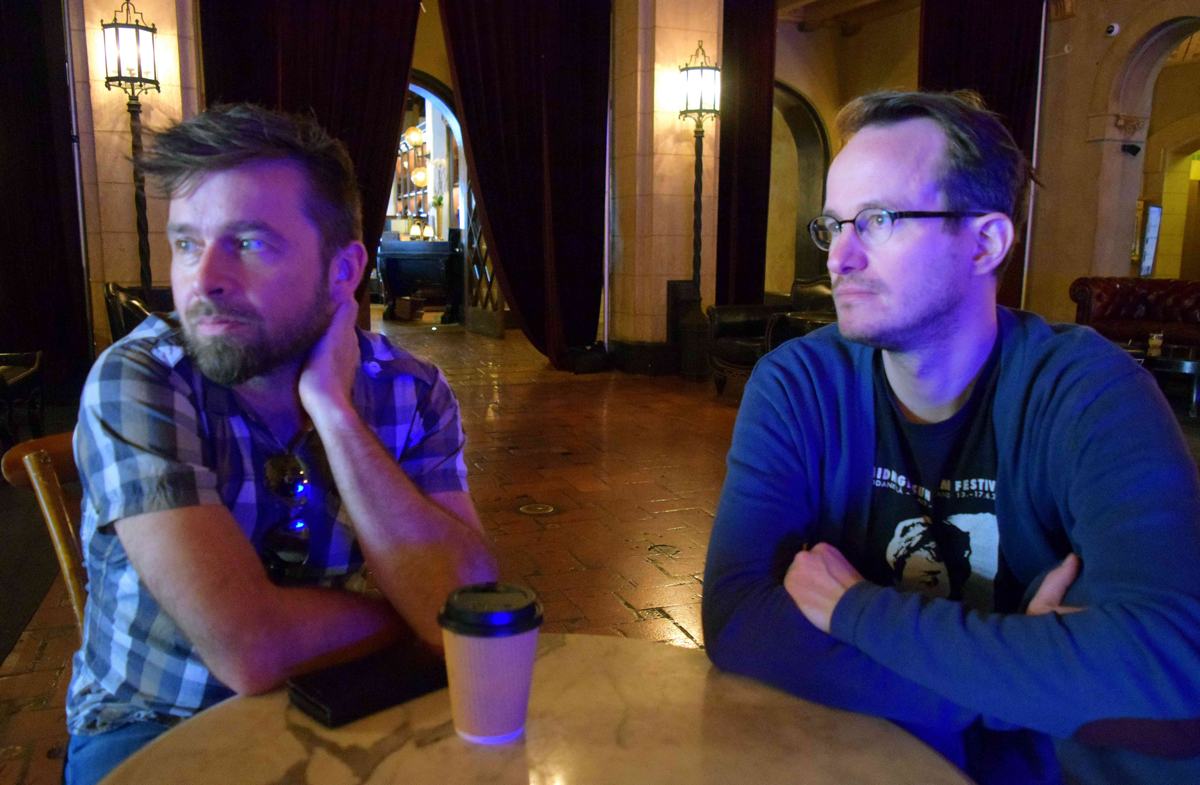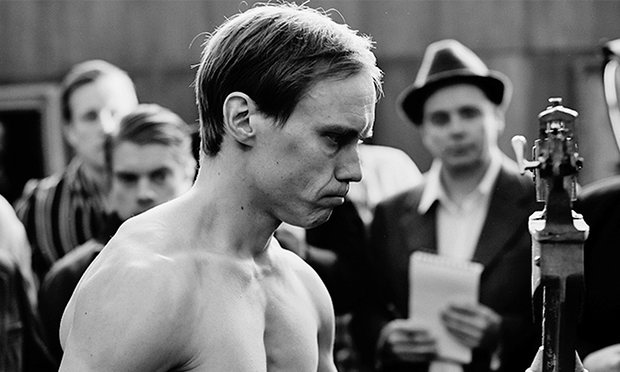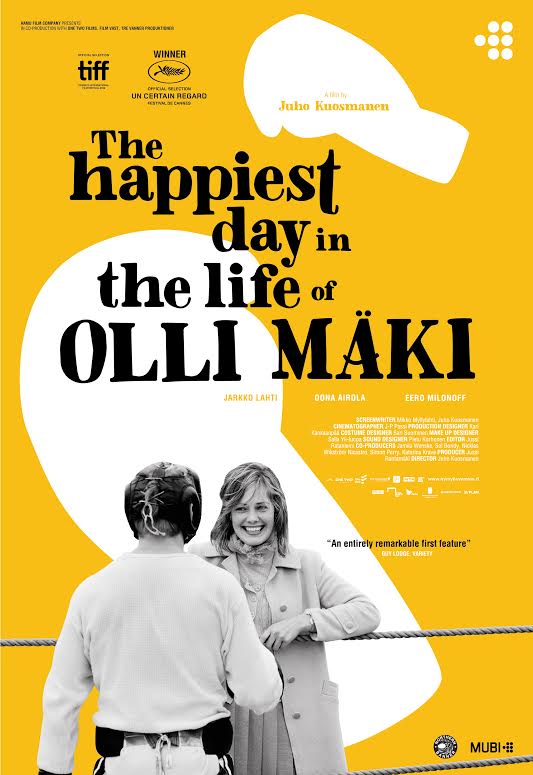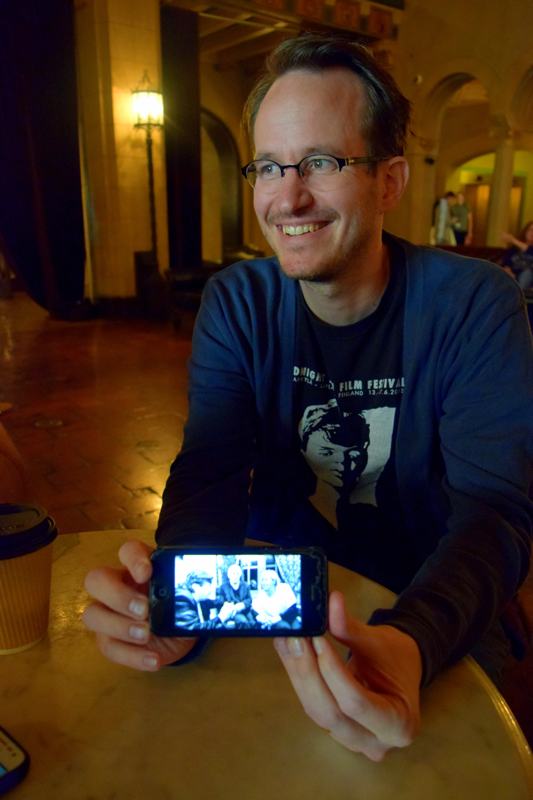
Juho Kuosmanen and J.P. Passi
by Generoso and Lily Fierro
In the midst of the frantic final day of this year’s AFI Film Festival, we were very excited to sit down at the Roosevelt Hotel in Hollywood with director Juho Kuosmanen and cinematographer J.P. Passi to discuss their wonderful new film, The Happiest Day in the Life of Olli Mäki, which was honored with Un Certain Regard at this year’s Cannes Film Festival. Their film is an endearing but critical look at the true story surrounding the highly publicized World Featherweight Title fight between the Finnish-born Olli Mäki and the American champion Davey Moore, which took place in Helsinki in 1962. Kuosmanen creates a unique boxing film, one that is less concerned with the Hollywood cliché of building up to the big fight and more interested in the manipulation of the media and the creation of a false heroes. In our conversation, we discuss Kuosmanen’s approach to telling this well-known story, the input he received from the real life Olli and his wife Raija, the challenges contained in hiding present day Helsinki to allow the film to appear like the early 1960s, and the good and the bad associated with making film in Finland under the shadow of the nation’s most applauded director, Aki Kaurismäki.
• •
Generoso Fierro : I understand that you were born in the same town as Olli Mäki, and so you knew of him, of course, but what aspect of his famed fight inspired you to tell his story?
Juho Kuosmanen : I think that came down to a moment after I had done some research about Olli Mäki when I discovered a documentary that was made about him during the period when they were trying to make him into the next world boxing champion. When I saw the documentary, I thought that there was something comical inherent in the contradiction of people wanting Olli to become a hero when Olli himself had the feeling that he had no chance of winning the fight.

G. Fierro: After speaking with Olli, do you feel that his belief that he was unable to win the fight was more from his inability as an athlete to beat Davey Moore or the fact that he felt that the promoters and his manager were building the whole event up in a way that wasn’t honest to Olli and the people who were buying tickets?
Kuosmanen: Olli knew at the time that the whole thing was fake—that the whole world that he is being dragged into is being built out of these images that weren’t real at all. For example, in the scene where Olli sees the photo advertisement of himself where he is taller than a model standing next to him as he and Raija are walking down the street, he knows that, in reality, he had to stand on a stool to be taller than the model; he knows he is living in an environment where everything is false.
G. Fierro: Was Olli aware of how good of a boxer Davey Moore was at the time?
Kuosmanen: Olli did know Moore’s record, but Olli and his manager also knew that Moore had issues with his weight and that he (Moore) was a bit past his prime at the time. So, even though Moore was the better boxer, he had weaknesses, so Olli’s manager did believe that there was some chance that Olli could win or at least go for more rounds so that the fight would make for a better event. Olli himself said that there was no chance of winning, and that is why everyone annoyed him so much as they kept insisting for their personal reasons that he would be the champion.
G. Fierro: Being from a boxing town (Philadelphia), I myself boxed when I was young. I have a genuine love for the sport, which is one of the reasons I really wanted to see your film, and I enjoyed how realistically you depicted boxing. One thing did strike me as odd when I watched your film. For many years, I remember there being a three-knockdown rule in place to protect fighters in the event that they hit the canvas three times. In your film, during the second and final round, Olli does get knocked down three times, but the referee allows him to continue fighting. I know that you studied the actual footage of the Moore/Mäki fight; is that what actually happened?
Kuosmanen: We did exactly reference the footage of the actual fight. At the time of the Moore vs. Mäki fight, the rules of the match could be agreed upon before the fight by both sides, and in this case, both Moore’s and Mäki’s team agreed to allow the fight to continue in the event that either boxer was knocked down three times. But again, this rule has to be agreed upon before the fight occurs as it did here.
G. Fierro: J.P., I wanted to compliment you, as the cinematography of the film is quite remarkable; it seems to fit the era perfectly. You said in the post screening Q&A that the film was shot on 16mm, but did you use a special film stock or an older camera or vintage lenses?
J.P. Passi : The film stock I used is Kodak 3X Reversal black and white stock. I used a modern camera, but I used very old Zeiss lenses.
Lily Fierro : J.P., yesterday, during the Q&A as well, you said you dreaded making a boxing film due to the fact that there are so many other boxing films that this film would be compared to, which is understandable. Can you talk a bit about filming the final fight sequence? That scene has some gloriousness to it, and it is beautifully shot, but it is not like any of the fight scenes in more legendary Hollywood boxing films like Raging Bull. Instead, Mäki’s final fight is shot in a way that magnifies Olli’s thoughts on the insignificance of the event.
Passi: We wanted there to be a clear difference between the way the sparring matches were filmed and the way that the final bout was filmed. We shot the sparring scenes with cameras in the ring with Olli, but when it came to the title fight, we wanted Olli to be alone in the ring with Moore, with the camera outside the ropes to create distance, so that we could amplify how Olli was feeling alone during the fight. It was much easier overall to shoot the final fight. The sparring scenes required us to be very close to the fighters, and to do this, we had to study their choreography, so we could get in close for the best shot while trying to avoid accidentally getting hit in the process.

G. Fierro: That level of intimacy does come through during the sparring with those closeup shots but also with the sound design, which was excellent in conveying how brutally the punches echoed when a boxer was hit. Did you use live sound for that, or was it all foleyed in post production?
Kuosmanen: Both actually. We did use the original sound, but we added so many foley layers.
Passi: Truthfully, the original sounds were not very fierce because the actors were not allowed to hit each other with real force, so we had to compensate for that.
Kuosmanen: When we did the foleys, we wanted to have more than the punch itself. We wanted to add textures to the sounds like sweaty skin; in the scene when they are sparring in the rain, we wanted to add wet layers. We worked with this Danish sound mixer, a sound designer, and a foley artist who were involved with the film even before shooting began, so yes, we had many discussions about the sound design before filming those scenes. They were all extremely talented. We knew that if you didn’t include these textures of leather, skin, and water that, in the end, it would end up sounding artificial.
G. Fierro: The film is set during August, but given that a large portion of the film is shot outdoors, and in Finland, you really only have a few months on the calendar in which you can shoot without fear of wintry weather. Did that cause issues with filming?
Kuosmanen: Not really. We started shooting on the last day of August and ended in the last week of October—six weeks in total.

G. Fierro: Were you able to shoot the film chronologically?
Passi: We did shoot all of the countryside scenes in the film in the first week. We broke the chronology early, but we tried to maintain the chronology as best as possible after that because it really helps the feel of the film when you can shoot in chronological order. That said, even though we were shooting in the countryside at the end of August, when we filmed the scene where Olli swims in the lake, the temperature was 10 degrees Celsius, which is quite cold.
G. Fierro: Have Olli and his wife Raija seen the film yet?
Kuosmanen: Seven times actually!
G. Fierro: They must really love it then, but was there anything onscreen that they objected to?
Kuosmanen: Both Raija and Olli saw the script beforehand, and the only thing that Raija objected to was that her character was smoking in the film, and she never smoked. We added that into the script because there were many scenes where Raija is just standing there with no dialog, and we thought that if she were smoking that it would make her appear less tense about what was happening, but since the real Raija didn’t like the idea, we removed that characteristic.
L. Fierro: Your film is not a period piece, but there is a difference between 1962 Helsinki and present day Helsinki. This isn’t so much an issue when shooting in the countryside, but how did you scout city locations?
Kuosmanen: It was very difficult at times. We wanted to shoot in many directions, but that was very hard to do sometimes.
Passi: The format was a huge help here. For example, there are a few scenes that we filmed where there are modern cars in the background of the shot, but because of the black and white texture and because we shot from a long distance, we were able to hide them from the audience.
Kuosmanen: We also filmed most of the city scenes at night, and post-production helped as well. In one of the shots, there was a large building that we had to wipe out, and we did that in post. In the scene at the airport, which we wanted to shoot 360, we would always have something modern in the background, but there was enough in the foreground that we could work with in order to make it look correct. We could move a camera one way, and if someone could position themselves in front of a modern object in the background, it would work; in one case, we even put an extra in front of a new garbage can that we couldn’t simply move. It sounds hard, but it was fun.
G. Fierro: This might be an odd question, but it’s inspired by a screening that we attended this past Sunday where we saw a Polish mermaid musical called The Lure. Before the screening, the director felt that she had to explain that she was happy to finally be able to make a musical in Poland because, for years, no one wanted to because Krzysztof Kieślowski hated musicals. What influence, if any, did Aki Kaurismäki, Finland’s most prominent director in the eyes of most of the world, have either directly or inspirationally?
Kuosmanen: Well, first I should show you this photo of Aki, Olli, and Raija. Aki actually arranged the screening and the afterparty for our film. While it was going on, he said lots of nice things, and he was joking when he said to me, “I have been waiting thirty-five years to have a colleague in Finland.” He also said that we shared two of the same locations and exactly the same images that are in his new film. Particularly, he pointed out the scene where Olli is walking alone with his suit on when he is traveling to the post-fight party; Aki has the same scene except that his character is walking the other way in the same place.

G. Fierro: That is wonderful. Were the real Olli and Raija on set for a lot of the shooting?
Kuosmanen: They were in two other scenes in the film as well. They are in the wedding scene that takes place in the countryside, and they are also in the stadium scene because that day they were both being interviewed for the newspapers about our film.
Passi: They used that opportunity to stage a photoshoot with the real Olli in the ring for the newspapers so that they could commemorate the occasion of that fight after fifty-four years. ◼
The Happiest Day in the Life of Olli Mäki: http://www.imdb.com/title/tt4771932/












